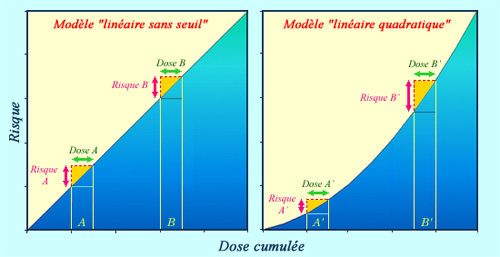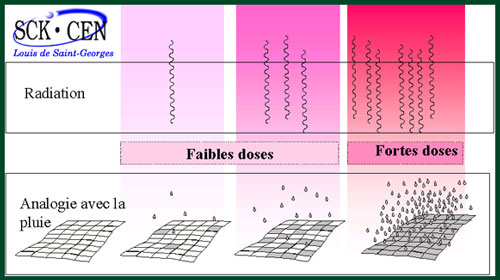What is the cumulative exposure?

Linear or quadratic relationship?
The figure compares the effect of an elementary dose depending on whether the cumulative dose is linear (left) or increases more rapidly (right). In the first case, equal doses A and B correspond to equal risks. In the second case, the effect of dose B’, which occurs after a significant cumulative dose, is more severe than that of dose A’. How to define the starting point of the cumulative dose? If cellular mechanisms repair damage, how long does it take for the effects of an exposure to be erased? © IN2P3
We receive an average of 2.5 millisieverts (mSv) per year from natural radioactivity alone, to which we are continuously exposed. At birth, the « page is blank », but the total exceeds 100 mSv by the age of 40. What dose do our cells count: a cumulative dose over a few months, a few years, or a lifetime?
To what extent can we ignore the previous dose and consider the doses as independent, as we usually do. In the low-dose regime, cells are randomly affected, and the number of affected cells is a function of the dose. It is legitimate to consider the doses as independent. As long as the irradiations affect a small fraction of cells, it is not the same cells that are affected from one irradiation to another, and the DNA repair mechanisms repair most of the damage in the meantime.

An analogy
An analogy with rain helps to understand the cumulative effect of low doses. During a « low dose », a small fraction of cells in the living organism, targeted by radiation, is affected. The situation is similar to sparse raindrops falling on dry soil: the raindrops hit distinct paving stones, some of which have time to dry (repair mechanisms). The number of targets hit is a function of the dose. It is chance that determines whether an affected cell evolves into a cancerous cell. During a heavy rain, on the other hand, all the paving stones are wet: all cells are affected, and the energy deposited is a function of the dose. Chance no longer plays a role. The effects are said to be deterministic.
© Louis de Saint-Georges/SCK.CEN
In the case of high exposures, all cells are affected, and the importance of the damage caused in the cells is what matters. The reality is complex, and we must take into account the history of exposures. If Nature « wipes the slate clean » of all or part of the exposures, how long does it take and to what extent does it repair the damage? We know little about this.
We must also take into account the « soil » of other carcinogenic factors, which are major confounding factors in studies aimed at estimating the risks of ionizing radiation. The risks of cancer induced by small doses are very low compared to the risk of cancer induced by toxins such as asbestos or tobacco. Thus, it is difficult to estimate the effect of radon, which is generally minimal, in the presence of a widely distributed pulmonary toxin like tobacco, which has a much greater importance.
At the most basic level, a cell does not distinguish whether a DNA break comes from a free radical produced by a carcinogenic agent like tobacco or from an ionizing particle. However, DNA breakage is only one factor in the genesis of cancer. The information is scarce on the influence of the incidence of other factors. The study of populations exposed to both a toxic agent and radiation allows us to observe cases where the increase is greater than the sum of the two exposures taken separately.
Certain substances interfere with DNA repair mechanisms. If they inhibit these mechanisms, they increase the action of radiation. We have observed a « synergy » for lung cancer between tobacco use and radon exposure in uranium mines. Synergy can also result from an indirect effect, such as the inhibition of the elimination of a radioactive product.
Learn more :
Other articles on the subject « Radiation Effects »
Deterministic effects
The domain of strong doses and severe, reproducible effects For high doses above a certain thresh[...]
Probabilistic effects
The domain of low and average doses For weak or medium-strength doses, the effects are not as cle[...]
Dose-effects Relationship
Can effects caused by low doses of radiations be predicted ? Even though we are constantly expose[...]
Dose Rate
Acute and chronic exposures The « effective dose » is not sufficient by itself to characterize on[...]
Hiroshima Nagasaki Survivors
An exces of cancers and leukaemia among survivors Our knowledge of the risks of cancers due to ra[...]
Linear No-threshold Model
A Precautionary Principle applied to radioactivity … Is it possible to predict the effects [...]
Low doses effects
Do low doses of radiation have any effect? Radioprotection experts commonly refer to doses below [...]
Radiosensitivity
Sensitivity of DNA in living cells to radiation Although we still know little about the effects o[...]
Radioactive Toxicity
A useful indicator but to be used appropriately … The danger presented by a radioactive sub[...]
Dose Factors
What doses when swallowing or inhaling radioactive atoms ? How to evaluate the doses resulting fr[...]